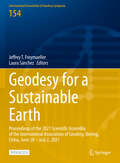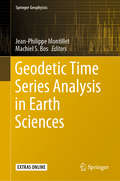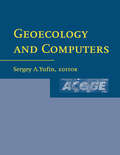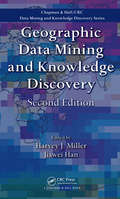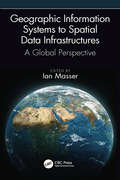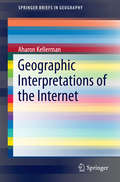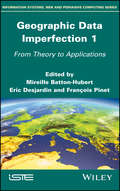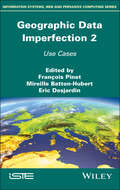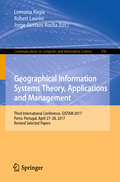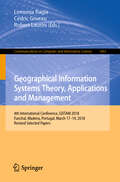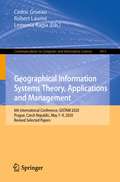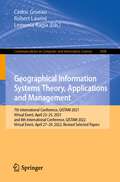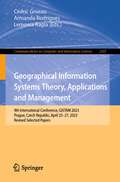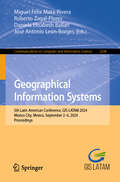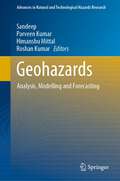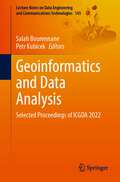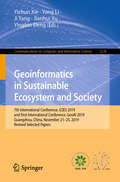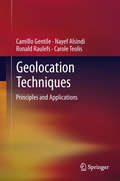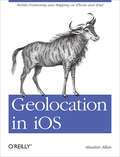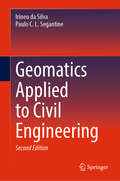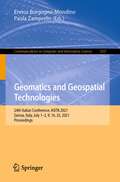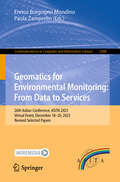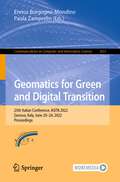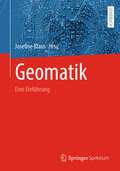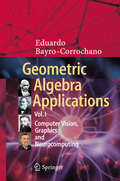- Table View
- List View
Geodesy for a Sustainable Earth: Proceedings of the 2021 Scientific Assembly of the International Association of Geodesy, Beijing, China, June 28 – July 2, 2021 (International Association of Geodesy Symposia #154)
by Jeffrey T. Freymueller Laura SánchezThis open access volume contains selected papers of the 2021 Scientific Assembly of the International Association of Geodesy – IAG2021. The Assembly was hosted by the Chinese Society for Geodesy, Photogrammetry and Cartography (CSGPC) in Beijing, China from June 28 to July 2, 2021. It was a hybrid conference with in-person and online attendants. In total, the Assembly was attended by 146 in-person participants and 1,123 online participants. The theme of the Assembly was Geodesy for a Sustainable Earth. 613 contributions (255 oral presentations and 358 poster presentations) covered all topics of the broad spectrum considered by the IAG: geodetic reference frames, Earth gravity field modelling, Earth rotation and geodynamics, positioning and applications, the Global Geodetic Observing System (GGOS), geodesy for climate research, marine geodesy, and novel sensors and quantum technology for geodesy. All published papers were peer-reviewed, and we warmly recognize the contributions and support of the Associate Editors and Reviewers.
Geodetic Time Series Analysis in Earth Sciences (Springer Geophysics)
by Jean-Philippe Montillet Machiel S. BosThis book provides an essential appraisal of the recent advances in technologies, mathematical models and computational software used by those working with geodetic data. It explains the latest methods in processing and analyzing geodetic time series data from various space missions (i.e. GNSS, GRACE) and other technologies (i.e. tide gauges), using the most recent mathematical models. The book provides practical examples of how to apply these models to estimate seal level rise as well as rapid and evolving land motion changes due to gravity (ice sheet loss) and earthquakes respectively. It also provides a necessary overview of geodetic software and where to obtain them.
Geoecology and Computers
by Sergey A. YufinThis volume presents technical papers devoted to development and practical use of computer methods in geotechnical and geoenviromental engineering. It covers issues on space use and construction, soil and rock mechanics, and mining applications amongst other topics.
Geographic Data Mining and Knowledge Discovery (Chapman & Hall/CRC Data Mining and Knowledge Discovery Series)
by Jiawei Han Harvey J. MillerThe Definitive Volume on Cutting-Edge Exploratory Analysis of Massive Spatial and Spatiotemporal DatabasesSince the publication of the first edition of Geographic Data Mining and Knowledge Discovery, new techniques for geographic data warehousing (GDW), spatial data mining, and geovisualization (GVis) have been developed. In addition, there has bee
Geographic Information Systems to Spatial Data Infrastructures: A Global Perspective
by Ian MasserThis book draws on author’s wealth of knowledge working on numerous projects across many countries. It provides a clear overview of the development of the SDI concept and SDI worldwide implementation and brings a logical chronological approach to the linkage of GIS technology with SDI enabling data. The theory and practice approach help understand that SDI development and implementation is very much a social process of learning by doing. The author masterfully selects main historical developments and updates them with an analytical perspective promoting informed and responsible use of geographic information and geospatial technologies for the benefit of society from local to global scales. Features Subject matter spans thirty years of the development of GIS and SDI. Brings a social science perspective into GIS and SDI debates that have been largely dominated by technical considerations. Based on a world-wide perspective as a result of the author's experience and research in the USA, Australia, Canada, Brazil, Peru, China, India, Korea, Malaysia, and Japan as well as most European countries. Draws upon professional and academic experience relating to pioneering UK and European GIS research initiatives. Includes updated historical material with an analytical perspective explaining what was done right, and what didn't work.
Geographic Interpretations of the Internet
by Aharon KellermanThis book introduces the Internet through a systematic geographical interpretation, thus shedding light on the Internet as a spatial entity. The book's approach is to extend basic concepts developed for terrestrial geography to cyberspace, most notably those relating to space, structure, place, distance, mobility, and presence. It further considers the Internet by its constitution of information space, communications space, and screen space. By using well-known concepts from traditional human geography, this book proposes a combination of terrestrial and virtual geographies, which may in turn help in coping with Internet structures and contents. The book appeals to human and economic geographers, especially those interested in information and Internet geographies. It may also be of special interest and importance to sociologists and media scholars and students dealing with communication technology and the Internet.
Geographical Data Imperfection 1: From Theory to Applications
by Mireille Batton-Hubert Eric Desjardin François PinetGeomatics is a field of science that has been intimately intertwined with our daily lives for almost 30 years, to the point where we often forget all the challenges it entails. Who does not have a navigation application on their phone or regularly engage with geolocated data? What is more, in the coming decades, the accumulation of geo-referenced data is expected to increase significantly. This book focuses on the notion of the imperfection of geographic data, an important topic in geomatics. It is essential to be able to define and represent the imperfections that are encountered in geographical data. Ignoring these imperfections can lead to many risks, for example in the use of maps which may be rendered inaccurate. It is, therefore, essential to know how to model and treat the different categories of imperfection. A better awareness of these imperfections will improve the analysis and the use of this type of data.
Geographical Data Imperfection 2: Use Cases
by Mireille Batton-Hubert Eric Desjardin François PinetGeographical data often contains imperfections associated with insufficient precision, errors or incompleteness. If these imperfections are not identified, taken into account and controlled when using the data, the potential for errors may arise, leading to significant consequences with unforeseeable effects, particularly in a decisionmaking context. It is then necessary to characterize and model this imperfection, and take it into account throughout the process. In the previous volume, we introduced different approaches for defining, representing and processing imperfections in geographic data. Volume 2 will now present a number of concrete applications in a variety of fields, demonstrating the practical application of the methodology to use cases such as agriculture, natural disaster management, mountain hazards, land management and assistance for the visually impaired.
Geographical Information Systems Theory, Applications and Management (Communications in Computer and Information Science #936)
by Jorge Gustavo Rocha Robert Laurini Lemonia RagiaThis book constitutes extended, revised and selected contributions from the Second International Conference on Geographical Information Systems Theory, Applications and Management, GISTAM 2016, held in Rome, Italy, in April 2016. The 10 papers presented in this volume were carefully reviewed and selected from a total of 33 submissions. They contribute to the understanding of relevant trends of current research on the topic, including urban and regional planning; water information systems; geospatial information and technologies; spatio-temporal database management; decision support systems; energy information systems; GPS, and location detection.
Geographical Information Systems Theory, Applications and Management: 4th International Conference, GISTAM 2018, Funchal, Madeira, Portugal, March 17–19, 2018, Revised Selected Papers (Communications in Computer and Information Science #1061)
by Cédric Grueau Robert Laurini Lemonia RagiaThis book constitutes the thoroughly refereed proceedings of the 4th International Conference on Geographical Information Systems Theory, Applications and Management, GISTAM 2018, held in Funchal, Madeira, Portugal, in March 2018.The 7 revised full papers presented were carefully reviewed and selected from 58 submissions. The papers are centered on urban and regional planning; water information systems; geospatial information and technologies; spatio-temporal database management; decision support systems; energy information systems; GPS and location detection.
Geographical Information Systems Theory, Applications and Management: 6th International Conference, GISTAM 2020, Prague, Czech Republic, May 7–9, 2020, Revised Selected Papers (Communications in Computer and Information Science #1411)
by Cédric Grueau Robert Laurini Lemonia RagiaThis book constitutes selected, revised and extended papers of the 6th International Conference on Geographical Information Systems Theory, Applications and Management, GISTAM 2020, held in Prague, Czech Republic, May 2020. Due to the COVID-19 pandemic the conference was held online. The 9 revised full papers presented were carefully reviewed and selected from 62 submissions. The papers are centered on urban and regional planning; water information systems; geospatial information and technologies; spatio-temporal database management; decision support systems; energy information systems; GPS and location detection.
Geographical Information Systems Theory, Applications and Management: 7th International Conference, GISTAM 2021, Virtual Event, April 23–25, 2021, and 8th International Conference, GISTAM 2022, Virtual Event, April 27-29, 2022, Revised Selected Papers (Communications in Computer and Information Science #1908)
by Cédric Grueau Robert Laurini Lemonia RagiaThis book constitutes selected, revised and extended papers of the 7th International Conference on Geographical Information Systems Theory, Applications and Management, GISTAM 2021, held in April 2021, and 8th International Conference on Geographical Information Systems Theory, Applications and Management, GISTAM 2022, held in April 2022. Due to the COVID-19 pandemic both conferences were held online. The 4 revised full papers presented at GISTAM 2021 were carefully reviewed and selected from the 44 submissions, and 3 papers presented at GISTAM 2022 were selected from the 27 submissions. The papers are centered on urban and regional planning; water information systems; geospatial information and technologies; spatio-temporal database management; decision support systems; energy information systems; GPS and location detection.
Geographical Information Systems Theory, Applications and Management: 9th International Conference, GISTAM 2023, Prague, Czech Republic, April 25–27, 2023, Revised Selected Papers (Communications in Computer and Information Science #2107)
by Cédric Grueau Armanda Rodrigues Lemonia RagiaThis book constitutes the refereed post-proceedings of the 9th International Conference on Geographical Information Systems Theory, Applications and Management, GISTAM 2023, held in Prague, Czech Republic during April 25–27, 2023. The 6 full papers included in this book were carefully reviewed and selected from 37 submissions. They focus on challenges in geo-spatial data sensing, observation, representation, processing, visualization, sharing and managing, in all aspects concerning both information communication and technologies (ICT) as well as management information systems and knowledge-based systems.
Geographical Information Systems: 5th Latin American Conference, GIS-LATAM 2024, Mexico City, Mexico, September 2–6, 2024, Proceedings (Communications in Computer and Information Science #2298)
by Roberto Zagal-Flores Miguel Félix Mata-Rivera Daniela Elisabeth Ballari José Antonio León-BorgesThis book constitutes the refereed proceedings of the 5th Latin American Conference on Geographical, Information Systems, GIS-LATAM 2024, held in Mexico City, Mexico, during September 2-6, 2024. The 14 full papers were thoroughly reviewed and selected from 35 submissions. The papers focused on the following topics: Sustainable Energy and Resource Management, Environmental Monitoring and Management, Public Health and Social Issues, Education and Technology in GIS, Climatic Patterns and Natural Disasters.
Geohazards: Analysis, Modelling and Forecasting (Advances in Natural and Technological Hazards Research #53)
by Parveen Kumar Sandeep Himanshu Mittal Roshan KumarThis book presents a comprehensive analysis of diverse aspects of geohazards. The growing vulnerability and exposure to failures in risk reduction and policy-making increases the severity of geohazard impacts by many folds. Therefore, detailed geohazard analysis, modelling and forecasting are needed to reduce the impacts of extreme events.An interdisciplinary approach to hazard mitigation provides an advanced tool for risk reduction. The book thus summarizes recent modelling and analysis techniques for hazard assessment and risk mitigation. Topics discussed in the book are hazard and risk associated with earthquakes, vulnerability assessment for landslides and avalanches, the assessment of tsunami risk in coastal regions, the implementation of early warning systems to prevent catastrophic consequences, climate change risk modelling and risk communication. The convergent approach with the aspects of natural, engineering, and social sciences attracts a vast audience working to advance disaster science. This book also significantly facilitates the acquisition of policy-relevant knowledge for risk reduction, which is beneficial to the general public.
Geoinformatics and Data Analysis: Selected Proceedings of ICGDA 2022 (Lecture Notes on Data Engineering and Communications Technologies #143)
by Salah Bourennane Petr KubicekThis book contains the proceedings of the 5th International Conference on Geoinformatics and Data Analysis (ICGDA 2022), held in January 21–23, Paris, France. Geoinformatics helps to support basic scientific inquiry as well as address the complex social and environmental challenges. It becomes very important technology to decision-makers across a wide range of disciplines such as computer science, information technology, software engineering, biogeography, geography, conservation, architecture, spatial analysis and reinforcement learning. The papers included in this proceeding share the latest research results and practical application examples on the methodologies and algorithms in the area of geoinformatics and data analysis, including software and information engineering, environmental geography and geographic information system, which makes the book a valuable reference for researchers, engineers and university students who are working in the field.
Geoinformatics in Sustainable Ecosystem and Society: 7th International Conference, GSES 2019, and First International Conference, GeoAI 2019, Guangzhou, China, November 21–25, 2019, Revised Selected Papers (Communications in Computer and Information Science #1228)
by Yong Li Yichun Xie Ji Yang Jianhui Xu Yingbin DengThis book constitutes the refereed proceedings of the 7th International Conference on Geoinformatics in Sustainable Ecosystem and Society, GSES 2019, and First International Conference on Geospatial Artificial Intelligence for Urban Computing, GeoAI 2019, held in Guangzhou, China, in November 2019.The 29 full papers and 3 short papers presented in this volume were carefully reviewed and selected from 80 submissions. The papers are organized according to the following topical sections: the applications of geospatial data in the sustainable development of social economy; new approaches for earth observation data acquisition and processing; remote sensing monitoring of resources and environment and intelligent analysis; intelligent perceptions and services of spatial information; ecology, environment and social sustainable development.
Geolocation Techniques
by Camillo Gentile Ronald Raulefs Nayef Alsindi Carole TeolisBasics of Distributed and Cooperative Radio and Non-Radio Based Geolocation provides a detailed overview of geolocation technologies. The book covers the basic principles of geolocation, including ranging techniques to localization technologies, fingerprinting and localization in wireless sensor networks. This book also examines the latest algorithms and techniques such as Kalman Filtering, Gauss-Newton Filtering and Particle Filtering.
Geolocation in iOS: Mobile Positioning and Mapping on iPhone and iPad
by Alasdair AllanTake advantage of iPhone and iPad sensors and advanced geolocation technologies to build state-of-the-art location applications. In this concise hands-on guide, author Alasdair Allan (Learning iOS Programming) takes you deep inside Apple’s Core Location framework, Map Kit, and other iOS tools, using illustrative examples and sample Objective-C code. Learn how to build location-aware apps for both iPhones and iPads, using code that detects hardware features and then adjusts your app’s behavior.If you’re a programmer with iOS experience, or a Mac developer familiar with Objective-C, this book helps you get off to a solid start in location-based app development.You’ll learn about:Core Location: Understand the significant-change location service and geo-fencing capabilitiesMap Kit: Embed maps into your application’s viewsMagnetometer: Use the on-board sensor as a digital compassGeocoding capabilities: Translate geographic coordinates into place names, and vice versaHeat maps: Get a code walkthrough for displaying these maps on top of a standard MapKit viewThird-party SDKs: Add unique geo-location capabilities to your app from SkyHook Wireless, MapBox, and other providers
Geomatics Applied to Civil Engineering
by Irineu da Silva Paulo C. SegantineThis textbook deals jointly with theoretical and practical concepts within geomatics in civil engineering, based on the global understanding of its use. Written by civil engineers with professional backgrounds in geomatics, the book has a number of unique characteristics, including analysis of geodetic references and their coordinate systems to allow their conversions and applications taking into account the local topographic plan; analysis of the measurements of directions, angles and distances, inserting them into the concepts of practical use of modern measuring instruments; detailed description of the main components of measurement instruments used in geomatics; discussion of instrumentation errors and their implications; and a complete study of UTM Projection System and its variants, equations, and practical application in civil engineering projects. For students and instructors, and practitioners, the subjects covered in the book are organized to cover most topics related to the disciplines of surveying or geomatics studied in civil engineering courses. It is entirely based on adjustment computation for spatial data analysis including coordinate geometry and traverse computation. To this end, an entire chapter is devoted to adjustment computation based on matrix theory to help readers understand its applications in spatial data analysis throughout the book’s chapters; including chapters on modern technologies such as conventional and UAV-based digital photogrammetry, digital terrain modelling, terrestrial laser scanning and BIM.
Geomatics and Geospatial Technologies: 24th Italian Conference, ASITA 2021, Genoa, Italy, July 1-2, 9, 16, 23, 2021, Proceedings (Communications in Computer and Information Science #1507)
by Enrico Borgogno-Mondino Paola ZamperlinThis volume constitutes selected papers presented at the 24th Italian Conference on Geomatics and Geospatial Technologies, ASITA 2021, held as five sessions takind place between 1 and 23 July, 2021. Due to the COVID-19 pandemic the conference was held online.The 28 papers were thoroughly reviewed and selected from 139 submissions. They are organized in topical sections on remote sensing applications; geomatics and natural hazards; geomatics for cultural heritage and natural resources; sensors performance and data processing; geomatics and land management.
Geomatics for Environmental Monitoring: 26th Italian Conference, ASITA 2023, Virtual Event, December 18–20, 2023, Revised Selected Papers (Communications in Computer and Information Science #2088)
by Paola Zamperlin Enrico Borgogno MondinoThis book constitutes the proceedings of the 26th Italian Conference on Geomatics for Environmental Monitoring: From Data to Services, ASITA 2023, which was held as a virtual event during December 18-20, 2023. The 19 full papers included in this book were carefully reviewed and selected from 42 submissions. They were organized in topical sections as follows: Natural hazards monitoring and modelling; technological services for territory planning and Management; methodological advancements in data analysis and processing.
Geomatics for Green and Digital Transition: 25th Italian Conference, ASITA 2022, Genova, Italy, June 20–24, 2022, Proceedings (Communications in Computer and Information Science #1651)
by Enrico Borgogno-Mondino Paola ZamperlinThis book constitutes the proceedings of the 25th Italian Conference on Geomatics for Green and Digital Transition, ASITA 2022, held in Genova, Italy, in June 2022.The 33 full papers included in this book were carefully reviewed and selected from 60 submissions. They were organized in topical sections as follows: Positioning, Navigation and Operational Geodesy; Data exploitation: services and tools; Geo(big)data, GeoAnalytics, AI and Decision Support; Agriculture and Forestry; Cultural Heritage and Landscape Analysis; Environmental Monitoring and Analysis; and Sustainable Development and Climate Change.
Geomatik: Eine Einführung
by Josefine KlausWas ist eine Mercatorabbildung? Wie berechnet man Koordinaten? Wie funktioniert ein Geoinformationssystem? Diese und viele weitere Fragen beantwortet „Geomatik - Eine Einführung“ und bietet damit zum ersten Mal die theoretischen Grundlagen der Ausbildung zur/zum Geomatiker:in in einem Werk.Folgende Themen werden auf der Grundlage des bundesweit einheitlichen Rahmenlehrplans der Berufsausbildung behandelt:Organisation des Vermessungswesen Erfassung, Bearbeitung und Präsentation von Geodaten Verwaltung von GeodatenGrundlagen des Web- und Printdesigns Selbstständige Entwicklung von GeoproduktenDie Inhalte werden ergänzt durch ein auf die Prüfungen angepasstes Lernangebot und zahlreiche weiterführende Informationsquellen. Dadurch entsteht ein umfassendes und zeitgemäßes Handbuch für den Berufsschulunterricht und zur Prüfungsvorbereitung im Bereich der Geoinformatik, Vermessung und Kartographie. Aus einer modernen, digitalen Wissensvermittlung sind die visuellen und kartenbasierten Ansätze der Geomatik nicht mehr wegzudenken. Die in diesem Buch angebotenen Informationen ermöglichen es angehenden Geomatiker:innen und Interessierten selbstständig eigene Geoprodukte zu erstellen.
Geometric Algebra Applications Vol. I: Computer Vision, Graphics and Neurocomputing
by Eduardo Bayro-CorrochanoThe goal of the Volume I Geometric Algebra for Computer Vision, Graphics and Neural Computing is to present a unified mathematical treatment of diverse problems in the general domain of artificial intelligence and associated fields using Clifford, or geometric, algebra.Geometric algebra provides a rich and general mathematical framework for Geometric Cybernetics in order to develop solutions, concepts and computer algorithms without losing geometric insight of the problem in question. Current mathematical subjects can be treated in an unified manner without abandoning the mathematical system of geometric algebra for instance: multilinear algebra, projective and affine geometry, calculus on manifolds, Riemann geometry, the representation of Lie algebras and Lie groups using bivector algebras and conformal geometry. By treating a wide spectrum of problems in a common language, this Volume I offers both new insights and new solutions that should be useful to scientists, and engineers working in different areas related with the development and building of intelligent machines. Each chapter is written in accessible terms accompanied by numerous examples, figures and a complementary appendix on Clifford algebras, all to clarify the theory and the crucial aspects of the application of geometric algebra to problems in graphics engineering, image processing, pattern recognition, computer vision, machine learning, neural computing and cognitive systems.
